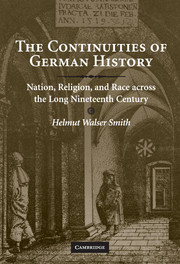Book contents
- Frontmatter
- Contents
- Introduction
- 1 The Vanishing Point of German History
- 2 The Mirror Turn Lamp: Senses of the Nation before Nationalism
- 3 On Catastrophic Religious Violence and National Belonging: The Thirty Years War and the Massacre of Jews in Social Memory
- 4 From Play to Act: Anti-Jewish Violence in German and European History during the Long Nineteenth Century
- 5 Eliminationist Racism
- Conclusion: Continuities in German History
- Acknowledgments
- Index
4 - From Play to Act: Anti-Jewish Violence in German and European History during the Long Nineteenth Century
Published online by Cambridge University Press: 05 June 2012
- Frontmatter
- Contents
- Introduction
- 1 The Vanishing Point of German History
- 2 The Mirror Turn Lamp: Senses of the Nation before Nationalism
- 3 On Catastrophic Religious Violence and National Belonging: The Thirty Years War and the Massacre of Jews in Social Memory
- 4 From Play to Act: Anti-Jewish Violence in German and European History during the Long Nineteenth Century
- 5 Eliminationist Racism
- Conclusion: Continuities in German History
- Acknowledgments
- Index
Summary
Long ignored by historians, the history of anti-Jewish violence has witnessed a remarkable surge in scholarly interest. This new work, which has illuminated both medieval and modern manifestations of anti-Jewish violence, allows one to conceptualize the tradition of violence and to ask questions about its patterns and significance. As we know from the standpoint of an interpretive study of culture, group violence, no matter how appalling, is almost never senseless, but instead expresses meaning and remains for the historian one of the most promising if disheartening avenues into the popular imagination. Similarly, speech said in the midst of violent acts (a specific category of speech act) represents an opening for a cultural history of anti-Semitism that takes seriously both its diachronic dimension and its contemporary context.
Historians are just now beginning to put this story together. Although the history of anti-Semitism is a rich field, it has tended to ignore the problem of violence, and, where it has not ignored the problem, it has tended to concentrate on explaining the causes of violence as opposed to discerning the significance and meaning, in an anthropological sense, of violent acts and words. Until recently, this was even true of major nation-tearing events, like the Dreyfus Affair. In 1998, Pierre Birnbaum could write in the introduction to The Anti-Semitic Moment:
A great deal is known about the Dreyfus Affair: the power of propaganda, the inventiveness of artists and writers, the frenzy of the press, the passion of the politicians, and the extent of the prejudice, which existed even without the institutions of the Republican government. […]
- Type
- Chapter
- Information
- The Continuities of German HistoryNation, Religion, and Race across the Long Nineteenth Century, pp. 115 - 166Publisher: Cambridge University PressPrint publication year: 2008
- 1
- Cited by



